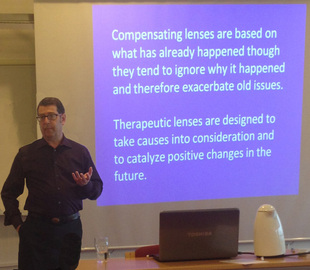
Steve Gallop spoke in an easy and understandable language for us foreigners, with lots of humour and not claiming that it was the one and only way. He just presented the technique to be yet another tool in our toolbox for helping our patients in the best possible way.
Other papers given at the E-KISS dealt with mindfulness and VT, the visual pathways and reading, ADHD, the connection between vision and motor and the importance of gross motor activities in VT, measurements, activities and questions to communicate out of office to reveal vision impairment and visual improvement, and discussions about patients kept out of the kind of VT (charged combination of in office and home VT) offered in Denmark.
The day before the E-KISS meeting, Steve Gallop was invited to give several lectures for the participants of the meeting. He talked about the connection between vision, posture, and movement, and he also discussed the difference between compensating and therapeutic lenses. He covered the importance of doing some kind of lens therapy for almost every patient with or without visual therapy. Changing their compensating prescription as soon as possible by really thinking of whether the necessity of cylinder and acuity should be above efficiency and comfort. Furthermore, Steve Gallop presented the way he was offering therapy in his office. The omission of home therapy was a rather new idea for most of the participants, and it left some thoughts for perhaps changing some daily routines ourselves to be able to embrace a larger group of patients, who for the moment have difficulty in fitting into our therapy.
Beside Steve Gallop's enlightening presentations, Steen Aalberg, OD, gave lectures on the importance of optometrists taking care of the binocular problems in the population. In Denmark about 70-80% of VT is performed by physiotherapists or occupational therapists, only thinking about vision in one eye and sometimes doing more harm than good – building up more compensations than doing rehabilitation.
In the era of technology in which technology is annihilating the clinical sense of the clinicians, clinicians submit their clinical thinking to the machines without questioning the results. Dr Steve Gallop brought a new fresh air. He will not be the doctor that get finger arthritis because of pushing the button of refractometer. He sees the patient was a hyperope but an entire human. He understands the importance of posture and movement in the development of the child's vision. Dr Steve taught how to arrange conditions in order to make the organism move in the right direction, making a more balance use of vision. He gave three presentations at the meeting. The presentation on prescribing astigmatism was full of consideration about space perception and distortion. We got tremendous insights and a vaccination against pushing the button of the automatic refractometer and prescribe the result. In his third presentation we got details and considerations about binasal occlusion. A part from his presentations, his comments where very enlightening and very good food for thought. We would like have him again in this wonderful room with natural light viewing the seaside.

 RSS Feed
RSS Feed

